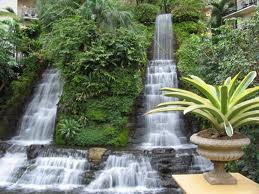





When it comes to creating dramatic effects, waterfalls and cascades, even modest examples, offer great opportunities.
The power of water as it tumbles over rocks gives the impression of something that can be awesome and unstoppable, but at the same time of great beauty. That beauty changes, too, being affected not only by the strength of the flow of water, but also by the effect of light on the moving water.

The character of a waterfall or cascade should be copied from nature, even if it will not he created from natural materials. An understanding of how waterfalls are formed is essential if the right ambience is to be created.
Waterfalls and cascades occur where the ground level changes, and can be created by swirls of water cutting through soil and stone. However, the most spectacular effects, and the kind of features that the majority of gardeners desire, result from water wearing relentlessly through solid rock and washing it away.
The strength of character that a natural waterfall or cascade can convey should be translated in the garden. Be bold and make a generous feature. Nothing looks worse than a small fall, fed by an inadequate pump. Indeed, pump technology, can make or break a waterfall. An adequate pump with spare capacity is essential if the correct effect -is to be created. With the range of modern equipment at the disposal of water gardeners, there is no excuse for producing anything other than a moving spectacle.
The materials from which a waterfall can be constructed are many and varied, but most water gardeners choose rock. Provided that this is sufficiently tough to withstand the battering meted out by a waterfall, there is no doubt that it is the safest material to use from a design aspect.
In the majority of gardens, a waterfall will form part of a rock garden, which is a particularly suitable arrangement. At the same time, it will often provide a perfect niche for plants that might be slightly difficult to grow. For example, the hardy moisture loving maidenhair fern, which loves life in a rocky pocket, will revel in the constant moisture from the spray produced by the waterfall. Dwarf mimulus, such as ‘Whitecroft Scarlet’, will be in their element in these conditions, too. So apart from being a natural link between the rock garden and pool, the waterfall allows the establishment of plants with special requirements.
To create a natural-looking waterfall, the rock must be carefully selected and the feature built so that all the strata lie in the same plane. The waterfall should appear to be an integral part of the rock garden, and not something imposed upon it, which is a major problem when preformed plastic or fibreglass cascade units are employed. Blending these into a rock garden waterfall is extremely difficult; they are more suitable for setting into a soil bank, where they can be disguised by heavy planting that will spread over the edges.
A waterfall in a rock garden outcrop need not necessarily be of the same material. It is quite possible to incorporate what, at first sight, may be considered an alien material if the rock feature is regarded as the stage, and the waterfall is tucked in behind. Under such circumstances, an obviously artificial waterfall can still be very appealing and will not detract from the natural surroundings. It can be likened to adding a sculpture to the garden. Many materials are suitable, but slate and marble are often recommended, although indulging in the latter will require a deep pocket.
For a really unusual material, choose glass, which, along with steel, is being used increasingly in modern formal gardens. While glass may not be to everybody’s taste, it must be remembered that there are many kinds to choose from, the slightly opaque reeded glass and dusky smoked varieties offering great artistic possibilities. The flow over a modern glass, or glass and steel, waterfall or cascade need not be as turbulent as over a fall that attempts to re-create nature. However, a constant, consistent flow, which will send water over the lip evenly and cleanly, is absolutely vital for a satisfactory effect. Make sure that a drip channel is cut into the underside of any flat glass spill to prevent the water from running back beneath it.
Whatever style of waterfall or cascade is eventually decided upon, take care to integrate it into the garden landscape. There is a great danger of the waterfall becoming an appendage to the water garden: something that is imposed upon it because of a desire for moving water. While the latter is very desirable, it must look as though it belongs. To ensure that this is the case, employ a waterfall or cascade as a linking element that will lead the eye gently down a slope, or cause it to drop and follow a sudden change in level. Where appropriate, strengthen the line of a path or steps by running such a feature alongside.
Copyright © www.100flowers.win Botanic Garden All Rights Reserved